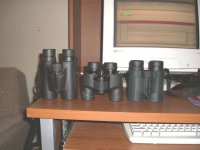jedku
Marc
Tilling,
If you realy will be using these bins alot with a kayak, keep in mind that they dont have as robust a construction as marine bins. The yosemites are "waterproof" by virtue of their rubber "O" rings under the ocular housing. They are still vulnerable to the ocular arm being banged out of alignment and they may not be truly immersable.
Individual focus marine bins, are very sturdy because their is no arm supporting the ocular lenses. They screw right into the housing and will stay waterproof longer. Most important, they will not go out of alignment easily if banged against the boat or while stored roughly in a gear bag.
Individual focus is not a serious problem from a boat. 6x will put alot in focus once you are just 25' away from your boat. Unless you try to use them in the woods or at a backyard feeder, you won't be refocusing them very much.
If you want something with central focus for use on land as well as water, roof prism designs are more suitable for true waterproofing and sturdier for being knocked around.
Eagle optics has a 6x, you will also do well with 7x, the marine standard magnification.
All of this is not to say you can't be happy with the Yosemites. It just depends on how rough you expect to treat them and whether you really want them to survive occasional full immersion. As a kayaker myself, I only take roofs or marine style porros out with me. Marine bins with scales etched on the glass are useful for navigation but annoying for birding....
Marc
If you realy will be using these bins alot with a kayak, keep in mind that they dont have as robust a construction as marine bins. The yosemites are "waterproof" by virtue of their rubber "O" rings under the ocular housing. They are still vulnerable to the ocular arm being banged out of alignment and they may not be truly immersable.
Individual focus marine bins, are very sturdy because their is no arm supporting the ocular lenses. They screw right into the housing and will stay waterproof longer. Most important, they will not go out of alignment easily if banged against the boat or while stored roughly in a gear bag.
Individual focus is not a serious problem from a boat. 6x will put alot in focus once you are just 25' away from your boat. Unless you try to use them in the woods or at a backyard feeder, you won't be refocusing them very much.
If you want something with central focus for use on land as well as water, roof prism designs are more suitable for true waterproofing and sturdier for being knocked around.
Eagle optics has a 6x, you will also do well with 7x, the marine standard magnification.
All of this is not to say you can't be happy with the Yosemites. It just depends on how rough you expect to treat them and whether you really want them to survive occasional full immersion. As a kayaker myself, I only take roofs or marine style porros out with me. Marine bins with scales etched on the glass are useful for navigation but annoying for birding....
Marc





